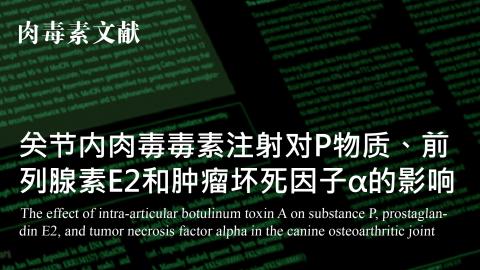
- 3120人
- 分享收藏
【肉毒素文献】关节内肉毒毒素注射对P物质、前列腺素E2和肿瘤坏死因子α的影响
The effect of intra-articular botulinum toxin A on
简介
【 文献重点摘要 】
Background: Recently, intra-articular botulinum toxin A (IA BoNT A) has been shown to reduce joint pain in osteoarthritic dogs. Similar results have been reported in human patients with arthritis. However, the mechanism of the antinociceptive action of IA BoNT A is currently not known. The aim of this study was to explore this mechanism of action by investigating the effect of IA BoNT A on synovial fluid (SF) and serum substance P (SP), prostaglandin E2(PGE2), and tumor necrosis factor alpha (TNF-α) in osteoarthritic dogs. Additionally, the aim was to compare SF SP and PGE2 between osteoarthritic and non-osteoarthritic joints, and investigate associations between SP, PGE2, osteoarthritic pain, and the signalment of dogs. Thirty-five dogs with chronic naturally occurring osteoarthritis and 13 non-osteoarthritic control dogs were included in the study. Osteoarthritic dogs received either IA BoNT A (n= 19) or IA placebo (n= 16). Serum and SF samples were collected and osteoarthritic pain was evaluated before (baseline) and 2 and 8 weeks after treatment. Osteoarthritic pain was assessed with force platform, Helsinki Chronic Pain Index, and joint palpation. Synovial fluid samples were obtained from control dogs after euthanasia. The change from baseline in SP and PGE2 concentration was compared between the IA BoNT A and placebo groups. The synovial fluid SP and PGE2 concentration was compared between osteoarthritic and control joints. Associations between SP, PGE2, osteoarthritic pain, and the signalment of dogs were evaluated.
Results: There was no significant change from baseline in SP or PGE2 after IA BoNT A. Synovial fluid PGE2 was significantly higher in osteoarthritic compared to control joints. Synovial fluid PGE2 correlated with osteoarthritic pain. No associations were found between SP or PGE2 and the signalment of dogs. The concentration of TNF-α remained under the detection limit of the assay in all samples.
Conclusions: The results suggest that the antinociceptive effect of IA BoNT A in the joint might not be related to the inhibition of SP nor PGE2. Synovial fluid PGE2, but not SP, could be a marker for chronic osteoarthritis and pain in dogs.
Keywords: Intra-articular botulinum toxin A, Substance P, Prostaglandin E2, Tumor necrosis factor alpha, Osteoarthritis, Pain, Dog
背景:最近,关节内注射肉毒杆菌毒素A(IA BoNT A)被证明可以减轻骨性关节炎犬的关节疼痛。类似的结果在人类关节炎患者中也有报道。然而,IA BoNT A的抗伤害作用机制目前尚不清楚。本研究旨在通过观察IA BoNT A对骨关节炎犬关节液(SF)和血清P物质(SP)、前列腺素E2(PGE_2)、肿瘤坏死因子-α(TNF-α)的影响,探讨其作用机制。此外,目的是比较SF、SP和PGE2在骨关节炎和非骨关节炎关节中的差异,并调查SP、PGE2、骨关节炎疼痛和狗的信号之间的关系。35只患有慢性自然发生骨关节炎的犬和13只非骨关节炎对照犬被纳入研究。骨关节炎犬接受IA BoNT A(n=19)或IA安慰剂(n=16)治疗。在治疗前(基线)、治疗后2周和8周收集血清和SF样本,并评估骨关节炎疼痛。骨关节炎疼痛采用FORCE平台、赫尔辛基慢性疼痛指数和关节触诊进行评估。取安乐死后对照犬关节液标本。比较IA BoNT A组和安慰剂组中SP和PGE2浓度与基线的变化。比较骨关节炎组和对照组关节液中SP和PGE2的浓度。评估了SP、PGE2、骨关节炎疼痛和狗的信号之间的关系。
结果:IA BoNT A后SP和PGE2水平与基础值无明显变化,骨性关节炎组滑液PGE2水平明显高于对照组,差异有统计学意义,骨性关节炎患者关节滑液PGE2水平明显高于对照组。滑液PGE2与骨性关节炎疼痛相关。未发现SP或PGE2与狗的信号传递有关。所有样品中肿瘤坏死因子-α的浓度均保持在该方法的检测限以下。
结论:IA BoNT A的关节抗伤害性作用可能与抑制SP或PGE2无关。滑液PGE2,而不是SP,可能是犬慢性骨关节炎和疼痛的标志物。
关键词:关节内肉毒毒素A,P物质,前列腺素E2,肿瘤坏死因子α,骨关节炎,疼痛,狗



